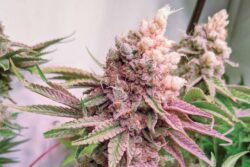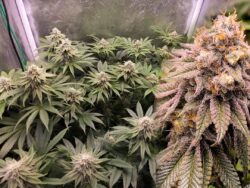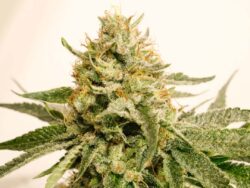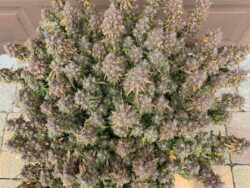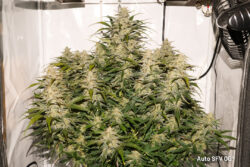How many cannabis plants per square meter?

Some growers like high numbers of plants in their tent. Although the yield per plant may be low, the sheer numbers of plants can make up for that. Other growers prefer the less cluttered approach of fewer plant numbers in large containers which may produce an equivalent yield. More experienced growers may feel that certain specialist growth techniques such as SOG, SCROG and LST can allow them to squeeze extra yield from their tent.
Often growers are hoping to find a grow method which will optimise the yield from their particular grow space and maximise their harvests. So what exactly is the best way to make the best use of your own grow space and how many plants are optimum per square metre?
How many plants can I grow in a square meter?
Most growers would grow around 3-4 plants per square metre. But if you grow with the SCROG (Screen of green) method you may only need one or two plants. Those using the SOG (Sea Of Green) method might aim for 16 plants in 4 rows of 4 containers. Much depends on the type of cannabis seeds you plan to grow, the power of your light, your preferred grow method, and your attitude towards plant training. These factors are discussed in detail later.

Define the size and shape of your final pots
The size of the plant container is important in several different regards. For SCROG growers, larger grow containers are preferred, allowing the grower to cultivate large plants with a sizeable root network which can support generous bud production above ground. For SOG growers, smaller containers allow more plants in the grow room. Small containers are adequate for the modest size of most SOG plants.
The size of your plant containers is particularly important to SOG growers. If your plant containers have a 25cm diameter (round or square) you will be just able to fit four rows of four plants (16 in total) in a 100cm x 100cm (1m x 1m) grow tent. If you use 20cm wide plant containers you will be able to fit 25 plants (5 rows of 5 plants) in a 1m x 1m grow space.
The following table lives an approximate guide to the number of plants you can fit in a 1m x 1m grow tent/grow space for a given container size. Note that the height/width of plant pots can vary. This means a 10-litre container could be very wide and shallow, or very tall and narrow. The table provides typical container numbers which can be reasonably fitted in a 1m x 1m tent.
| Pot Size (litres) | N° Plants/m2 |
| 3 | 25 |
| 5 | 18 |
| 11 | 9 |
| 15 | 5-6 |
| 18 | 3-4* |
| 21 | 2-3* |
* Note more containers can physically fit into a 1m x 1m space than indicated. But the resulting plants also need space to grow. So you may be able to get many more than two/three x 21 litre containers in your tent. However, here would be little room for the resulting plant growth. For that reason, these plant numbers in a 1m x 1m tent are just a guide which depends very much on your genetics, grow style, light, personal preferences etc.
Choose the right cannabis seeds for your grow space
Just because you can fit 25 plants into your 1m x 1m tent doesn’t necessarily mean that it’s the best idea or the right solution for you. Some growers find it easier to grow a more manageable 3-4 plants. Others that don’t mind a little SCROG maintenance would enjoy growing perhaps a single monster plant. Sativa plants can grow rapidly with significant vertical stretch, not all of them will suit a crowded tent. Indica cannabis seeds can give rise to shorter, stockier plants.
Some strains are prone to extensive side branching, that could suit some growers and not others. Autoflowering cannabis seeds, dependent on the genetics, often produce compact manageable plants. But some auto strains can also do a good job filling a 1m x 1m grow space with just a single plant in a large container with optimised conditions.
Remember also that use of grow techniques such as SCROG can allow stretchy sativa strains to fit well in a low-height grow room. The right grow technique can allow you to grow cannabis seeds which might not otherwise suit your personal grow room conditions/dimensions.
Consider the type of lights as well as their wattage

The following tables show a guideline for approximate light wattage for two of the most common grow lights, LED and HPS. HPS tends to be the most affordable way to set up an indoor grow. A basic 600W HPS light can be bought for around (or under) €/£/$75-100. Of course, there are high and low-quality lights available in range of options. These numbers are just guidelines to the types of HPS light used by typical growers with different sized grow rooms.
HPS Lights
| HPS Light wattage | HPS light footprint |
| 150W | 0.6 x 0.6m |
| 250W | 0.8 x 0.8m |
| 400W | 1 x 1m |
| 600W | 1.2 x 1.2m |
| 1000W | 1.5 x 1.5m |
For high quality LED lights, slightly lower wattages per square metre can be used. But as with HPS, check the manufacturers recommendations. Some LED manufacturers pride themselves on the highest efficiency chips. Others will use the cheapest LEDs with far lower PPFD (light intensity) output. For that reason, the numbers in the table (below) are just approximate guidelines. Always check manufacturers guidelines for LED hanging heights. These vary from manufacturer to manufacturer depending on the light design.
These days, most serious home growers and many licensed cannabis producers insist on LED grow lights since they deliver the highest quality results. THC levels (and other cannabinoids) are measurably higher when plants are grown under LED compared to HPS. Heat production from LED is lower, the light spectrum is superior and energy consumption is lower thanks to the inherently superior efficiency of LED technology compared to ageing HPS lighting.
LED Lights
| LED Light wattage | LED light footprint |
| 100-150W | 0.6 x 0.6m |
| 200-300W | 0.8 x 0.8m |
| 300-500W | 1 x 1m |
| 400-650W | 1.2 x 1.2m |
| 650-1000W | 1.5 x 1.5m |
The LED light wattages used in the table (above) would be suitable for plants grown from photoperiod feminised cannabis seeds. Plants grown from autoflowering cannabis seeds will be fine with lower light levels since autos typically use a 20/4 (or similar) light schedule. With so many daylight hours, autoflower plants can suffer light burn/light stress from over-exposure to excessively powerful grow lights.
Evaluate which training techniques are best suited to your grow space and your preferred cannabis seeds
You can choose between growing a small number of heavy yielding plants. Or to grow larger numbers of plants even though the average yield per plant may be lower. For many growers the main priority is an enjoyable grow with a cultivation method which is manageable, uncomplicated, and familiar. For other growers yield is king. Maximising bud production per square metre is the ultimate goal no matter how much complication that necessitates.
Some growers have the experience to grow with any type of cultivation method. Others prefer to stick with the grow techniques which have always worked best for them. Many growers enjoy the simplicity of growing their plants in the natural way, without any training or control techniques. If you’re a less experienced grower, just growing your plants in the natural way and keeping your grow room simple is rarely a bad idea.
| Training technique | N° Plants/m2 |
| SOG | 9 – 16 |
| Topping / FIMing | 2 – 9 |
| LST | 1 – 4 |
| SCROG | 1 – 4 |
| Mainlining | 1 – 4 |
SOG: 9-16 plants per m2
With a SOG grow the plants tend to be grown in small containers which provide sufficient space/nutrition to grow small/medium sized plants with limited side growth. Much of the SOG bud production comes from the main bloom. When growing photoperiod feminised cannabis seeds a short period of vegetative growth (1-2 weeks) is all that is usually required.
Growing with the SOG method won’t suit everyone and not all cannabis genetics ideally lend themselves to SOG growing. It can be fiddly watering e.g. 16 SOG plants in a cramped 1m x 1m grow space. Some growers also dislike the paranoia of having large plant numbers. But for others a SOG grow is predictable and straightforward. Many wouldn’t grow with any other technique. If you’re interested in cannabis SOG growing, then the following review provides in-depth expert tips and advice.
Topping / FIMing: 2-9 plants per m2

One way to increase the lateral side growth of a cannabis plant is to top or ‘fim’ the plant. This means cutting off the growth tip of the plant. The plant responds to the loss of its main growth point by producing side branches.
With topping, the main tip is replaced by two vigorous side branches. With the ‘FIM’ technique, the hope is to produce somewhat more than two side branches, perhaps 4-6. Though the FIM technique is notoriously difficult to master for many.
Once the apical growing tip (meaning the ‘apex’) of the cannabis plant is removed, vertical growth is reduced, and side growth increased. Cannabis genetics that would have produced tall, slender plants will produce shorter, bushier plants after topping/fimming. For growers that can mean a 1m x 1m grow space could be filled with less plants. The plant container size will, as always, play a large role in dictating the final plant size. So will the type and power of the grow light.
One advantage of topping/fimming your plants is that you can produce a flatter, more level canopy where more of the blooms are equidistant from the light source. This maximises efficiency since more of the blooms can thrive in optimised light levels. Whether you’re growing autoflowering cannabis seeds or feminised seeds you can top/fim your plants. By growing your harvest with fewer plant numbers, topping/fimming can also save you money since you may need to buy less cannabis seeds compared to e.g. SOG growing.
For those curious to know more about the pros and cons of topping autoflower plants, the following is essential reading.
LST: 1-4 plants per m2

LST is the technique of growing cannabis with low stress training methods such as tying down branches with cord. Sometimes LST is combined with SCROG or topping. The principle behind LST is to prevent the main bloom towering over the rest of the plant, forcing lower branches to accept reduced light intensities.
By tying down the main bloom it allows a flatter, more even canopy where (in theory) more of the blooms can grow in the optical sweet spot of maximised light levels. The result for the grower can be significantly increased yields per plant and better grow room utilisation. The downside is that the grower has to tolerate a certain amount of extra work in the grow room. You can use the LST technique whether you’re growing autoflower seeds or photo-dependent feminised cannabis seeds.
In a 1m x 1m grow tent you can grow between 1-4 cannabis plants with LST, dependent on issues such as the genetics, period of vegetative growth etc. For an expert-level deep dive into LST the following review is recommended reading.
SCROG: 1-4 plants per m2

SCROG (Screen of green) is another popular cannabis cultivation technique which is used by many growers to maximise their yield. Use of a metal wire mesh screen with approximately 5cm squares is recommended. These are available on rolls or sheets at many builders merchants or DIY centres and can be used year after year.
As the plant grows, the branches are weaved through the screen, or clipped to it with cable ties. A dense flat canopy is created which ensures that the blooms are all equidistant from the grow light in optimised light intensity levels. The result can be a serious yield increase from your tent, especially when using high production cannabis seeds.
Some SCROG grows are made on a flat screen. Others use a ‘stadium’ SCROG screen where the sides of the screen are raised upwards. Stadium grows are popular with scroggers that use a powerful point light source (such as a 1000W HPS). The raised sides of the screen allow blooms on the edges to get their fair share of light.
The only downside of the SCROG method is that a certain amount of planning is required with a small amount of daily maintenance. However, many SCROG specialists would say that once you get into a routine, SCROG really is easy and straightforward. The Dutch Passion SCROG guide is below, packed with useful detail and expert practical tips from a real SCROG master!
SCROG and SOG are two of the more common grow techniques used by those aiming to maximise yields from their grow space. The contrasting techniques both work well despite having different approaches to plant numbers, container sizes and length of vegetative growth period. If you want to review an in-depth comparison of SOG vs SCROG then the following guide is useful reading.
Mainlining: 1-4 plants per m2

Mainlining is a type of hybrid cannabis cultivation technique which combines the principles of topping, SCROG, lollypopping (removal of lower branches) and LST. Cannabis plants are often topped around the 3rd node with lower branches removed.
The plants can be topped a second or even a third time in order to produce multiple colas and a flat canopy of blooms. When done well this this can fill your grow space quickly, depending on how many colas, the size of your pots, grow light etc. If you’re growing in a 1m x 1m grow space you may only wish to fit in 1-4 mainlined plants. When growing photoperiod feminised cannabis seeds, long periods of vegetative growth can produce large plants which can quickly fill the grow space.
Critics of mainlining argue that it is a slightly more sophisticated and fiddly cannabis cultivation method which does require effort and may not suit less experienced growers. But if you like watching the flowering process and appreciate seeing plenty of cannabis blooms then mainlining could be for you.
Less can be more with cannabis
There are no firm rules on the ‘best’ numbers of plants to grow in a 1m x 1m grow tent/grow space. With so many different approaches to cannabis cultivation (and so many different types of cannabis seeds) it should be clear that there are different grow techniques available according to the preferences and style of the grower. More experienced growers may feel quite comfortable with all the techniques discussed. Many experienced growers swap between the different grow methods according to the genetics they are growing.
Some people rapidly adapt to the new demands of e.g. caring for large numbers of SOG plants squeezed into a small area. Others might find it a burden and an unenjoyable grow experience.
Less experienced growers are reminded that less is often more when it comes to cultivation. Keeping things simple with fewer plants to care for and a less cramped grow space can be a winning recipe for newer growers, allowing them to build confidence and gain experience before tackling more complicated methods. This can allow better control and more manageable conditions, especially for those that may have only grown a few times before.
Brand new cannabis growers with a 1m x 1m grow space may well find that the easiest approach is to grow 3-4 autoflowers in e.g. 20 litre grow sacks of organic soil without any grow techniques, allowing the autos to grow naturally. Use slow release organic nutrients such as those from BioTabs and you may only need to add water throughout the grow, keeping your grow as simple as it can get. More experienced growers won’t worry about setting up a SCROG grow or conducting some LST.
Know your own skills/limitations and set yourself realistic targets until your experience picks up. Much of this review has discussed ways of maximising yields but remember also that for many self sufficient growers quality is just as important, maybe more so. Buy the best quality cannabis seeds you can get and enjoy your next grow!













